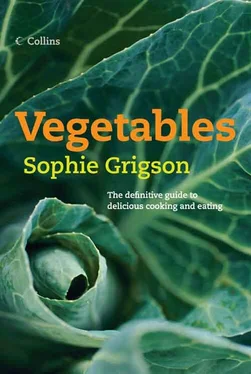As entries go, this one will be very short. Not because Hamburg parsley doesn’t rate, but more because it has become increasingly hard to find. I don’t think I’ve seen it for sale for the best part of a decade, more’s the pity. Therefore my aim now is merely to prime you, just in case you stumble across a tray of Hamburg parsley unexpectedly. If you do, please buy some and encourage the seller/grower to spread the word.
Although it looks like a shocked parsnip, colour washed out to ghostly off-white, and is about the same size and shape, Hamburg parsley is actually nothing more unusual than a form of the commonest of herbs, parsley. They share the same Latin name, Petroselinum crispum, but the energy flows down to the root of the Hamburg variety, swelling it out to a satisfying girth. Not for nothing is it also known as parsley root. It is far less sweet than a parsnip and does have a distinct parsley zing, which is surprising at first.
Although you could serve it as a straight vegetable, just boiled and buttered, the flavour is strong. In practice, it is more usual to add it in moderation to stewsand soups, cut up into chunks. In this context, it blossoms, imparting something of its parsley scent to the whole, and absorbing other flavours to mollify its own in a most beguiling manner. If you have only one or two roots, you might prefer to boiland mashthem with double or triple quantities of potato and plenty of butter to make excellent, parsley-perfumed mash to accompany some dark, rich, meaty stew.
Once upon a time, many centuries ago, intrepid explorers crossed the Atlantic Ocean at great peril and discovered all sorts of miraculous things. There were potatoes and tomatoes and chocolate and gold. There were chillies to make up for a dismaying lack of black pepper. Less lauded and celebrated, however, was the discovery of the Helianthus tuberosus. It belongs to a later period of exploration and intrepidity, when the pioneering spirit of the first settlers in North America led them to the flaps of Native American tepees. This time, along with turkeys and cranberries, they also sampled the delights of one of the windiest vegetables known to man, the knobbly Jerusalem artichoke.
Not as celebrated as potatoes or tomatoes and never exported with quite the same passionate love/hate devotion, nonetheless the Jerusalem artichoke was a significant addition to the greater vegetable repertoire. It has since gone in and out of fashion and now hovers amongst the bevy of vegetables that are almost but not quite popular, but still beloved by many devotees.
I count myself amongst them. Jerusalem artichokes are delicious and special and still remarkably seasonal. This is a crop that belongs to the late autumn and winter, a root vegetable with the gorgeous natural sweetness that slow growth in the darkness of moist earth imparts. Knobbly they may be, but the texture of the cooked tuber is smooth and gently crisp, defying comparison with others.
There is, as the name suggests, a passing resemblance in flavour to globe artichokes but there is no way you could confuse the two. The Jerusalem artichoke is very much its own man. With one half of the name explained, you might then wonder why a native American vegetable has acquired a Levantine moniker. The answer is simple: corruption. Not fraudulent illegal corruption, but verbal. The Jerusalem artichoke is closely related to the sunflower and, like the sunflower, its open-faced flower follows the sun from morning to evening. The Italian for sunflower is ‘girasole’, translating literally as turning towards the sun. ‘Jerusalem’ is merely a mispronunciation of this, lending an added exoticism to a vegetable that has travelled far.
Not so exotic is its propensity to flatulence. Theories abound as to how to minimise the after-effects, but to be frank I’ve never been that bothered. Except once, when I was breastfeeding my first child. A generous helping of Jerusalem artichokes gave rise to a distinctly sleepless night, and a very cranky mother and baby. Lactating mothers apart, I would suggest that you just accept that Jerusalem artichokes will induce wind to some degree, and ignore it. The taste is too good to let a minor inconvenience put you off.
As if to make up for their inherent windiness, Jerusalem artichokes are often grown as windbreaks along the edge of a vegetable garden. They are easy and undemanding, ideal for the not-so-green-fingered gardener, reproducing silently and prolifically underground as the tall stems stretch upwards to protect less hardy plants.
There are two key things to bear in mind when buying Jerusalem artichokes. The first is that they should be fairly firm with just the slightest give (i.e. not as hard as a potato, but firmer than a tomato). The second is that it is worth spending a few extra seconds sorting through the box to select the least knobbly tubers. Charming and funny though the more knobbly ones look, the fact is that you are going to have to peel the wretched things at some point. Smaller knobbles will just have to be sheared off and discarded; larger ones may ultimately go the same way if you can’t be bothered to peel each and every one of them. In other words, you pay for a lot of waste.
The next issue is when to peel them. My mum always used to peel them after boiling – she thought it easier – but I veer the other way, preferring to peel them before they go into any pan. The first method is probably more economical in that it minimises waste, as the skin just pulls away, but it does mean that reheating will be necessary. Peeling them first means that they can be whisked straight from the pan to the table, which suits me better. Be aware, however, that peeled raw Jerusalem artichokes discolour very quickly. Within minutes they take on a rusty colour as they oxidise. To prevent this (especially if there is to be a time lapse between peeling and cooking) drop the prepared Jerusalem artichokes into a bowl of acidulated water (i.e. water with the juice of 1/ 2lemon, or a tablespoon or two of vinegar, swished in).
Jerusalem artichokes can be cooked in most ways. Plainly boiledor steamed, tossed with a squeeze or two of lemon and a knob of butter, and served hot is the most obvious. But equally as good (if not better) are roastartichokes, bundled into the oven still swaddled in their skins (no choice here), with a small slick of olive oil and a sprinkling of salt. Once cooked it is up to each consumer to decide whether to eat the skins or not. I’ve often included Jerusalem artichokes in stir-fries(they make a rather good substitute for water chestnuts), where if you get the timings right they retain a slight crunch, alongside the characteristic sweet nuttiness. They go fantastically well with chicken in a creamy stew, even better encased in puff pastry to transform the stew into a pie.
Some people like them rawin salads. I don’t. I do, on the other hand, like them lightly cooked and cooled in a tarragon or chervil-flecked dressing, to stand as a salad on their own, or to add to other ingredients. Nut oils – hazelnut or walnut – bring out the natural nutty taste of the vegetable. Prawns (or lobster if you fancy something really smart) and Jerusalem artichokes on a bed of watercress or rocket make a most appetising starter or main course in the middle of the cooler months. Grill or bake a rasher or two of pancetta or dry-cured bacon until crisp, perch it on top and you’re heading towards perfection.
Читать дальше












